INSTITUT SUPERIEUR D'ANTHROPOLOGIE
INSTITUTE OF ANTHROPOLOGY
ONLINE COURSES / COURS A DISTANCE
INSCRIPTION 2012 / Session III : Juillet 2012
REGISTRATION 2012 / Term III : July 2012
TURQUIE – 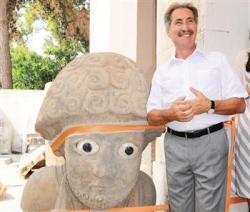 - Tell Tayinat - Culture and Tourism Minister Ertuğrul Günay has presented a newly discovered Hittite sculpture in Hatay’s Reyhanlı district. “There is no other similar piece in the world, it is unique,” Günay said of the sculpture that was found during excavations at the Tell Tayinat ancient site. The excavation works are being conducted under Toronto University Archaeology professor Timothy Harrison. The excavations have been ongoing since 2004 at the Tell Tayinat Tumulus, said Günay, who also thanked the excavation team for uncovering such a valuable piece. Noting that in June the team also found a number of other very valuable Anatolian figures, Günay said this new discovery was unique. “This sculpture is different. It is 1.5 meters long and it weighs 1.5 tons … It is a figure with a beard and long hair, and it seems to be holding a weapon. This shows that the society in these lands that it came from was a warrior one.” Noting that these sculptures revealed life before Christ, Günay said the founding also shed light on the early Hittite era in Turkey. The sculpture shows motifs similar to other Anatolian figures, but it is very different from other discoveries uncovered so far, said Günay. Although it is made of basalt stone, the eyes of the sculpture are artificial. The rest of the sculpture has not been found, indicating that it may well have been damaged. However, the upper part is in very good condition, said Günay. Harrison also showed that there is writing that says “Suppiluliuma” at the back of the sculpture.
- Tell Tayinat - Culture and Tourism Minister Ertuğrul Günay has presented a newly discovered Hittite sculpture in Hatay’s Reyhanlı district. “There is no other similar piece in the world, it is unique,” Günay said of the sculpture that was found during excavations at the Tell Tayinat ancient site. The excavation works are being conducted under Toronto University Archaeology professor Timothy Harrison. The excavations have been ongoing since 2004 at the Tell Tayinat Tumulus, said Günay, who also thanked the excavation team for uncovering such a valuable piece. Noting that in June the team also found a number of other very valuable Anatolian figures, Günay said this new discovery was unique. “This sculpture is different. It is 1.5 meters long and it weighs 1.5 tons … It is a figure with a beard and long hair, and it seems to be holding a weapon. This shows that the society in these lands that it came from was a warrior one.” Noting that these sculptures revealed life before Christ, Günay said the founding also shed light on the early Hittite era in Turkey. The sculpture shows motifs similar to other Anatolian figures, but it is very different from other discoveries uncovered so far, said Günay. Although it is made of basalt stone, the eyes of the sculpture are artificial. The rest of the sculpture has not been found, indicating that it may well have been damaged. However, the upper part is in very good condition, said Günay. Harrison also showed that there is writing that says “Suppiluliuma” at the back of the sculpture.
http://www.hurriyetdailynews.com/unique-sculpture-found-at-excavation.aspx?pageID=238&nID=26612&NewsCatID=375
EGYPTE – 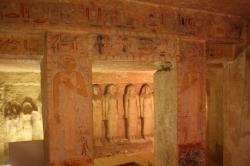 Gizeh - More than 4,500 years since the paint was first applied, the reds, yellows and blues still stand out on the walls of the tomb of Queen Meresankh III. A hunter throws a net to catch water birds, craftsmen make papyrus mats while a stream of people carry baskets filled with offerings for the afterlife. Decorating the walls all around are paintings, reliefs and statues of Meresankh, draped in a leopard-skin cloak, standing beside her mother in a boat, pulling papyrus stems through the water or being entertained by musicians and singers. Egypt’s tourism industry has been battered since last year’s revolution, but here, beside the pyramids of Giza, officials are trying to attract the visitors back. The tomb of Meresankh, whose name means lover of life, will be opened to the public for the first time in nearly 25 years later this year, while five other tombs of high priests — buried under the desert sands for decades — will be thrown open. Meresankh was a woman whose life was intimately bound up in the pharaoh’s incestuous rule. Her tomb lies a stone’s throw east of the Great Pyramid of her grandfather Khufu, better known as Cheops. Her parents were brother and sister, and she married another of Khufu’s children — her uncle, Khafre, better known as Chephren, who built the second-largest pyramid here. But Meresankh died suddenly, before her mother, who gave her own burial chamber for her daughter’s use. American archaeologist George Reisner wrote of his delight at the discovery in 1927 as his team poked their heads through a gap at the top of the sand-filled doorway.
Gizeh - More than 4,500 years since the paint was first applied, the reds, yellows and blues still stand out on the walls of the tomb of Queen Meresankh III. A hunter throws a net to catch water birds, craftsmen make papyrus mats while a stream of people carry baskets filled with offerings for the afterlife. Decorating the walls all around are paintings, reliefs and statues of Meresankh, draped in a leopard-skin cloak, standing beside her mother in a boat, pulling papyrus stems through the water or being entertained by musicians and singers. Egypt’s tourism industry has been battered since last year’s revolution, but here, beside the pyramids of Giza, officials are trying to attract the visitors back. The tomb of Meresankh, whose name means lover of life, will be opened to the public for the first time in nearly 25 years later this year, while five other tombs of high priests — buried under the desert sands for decades — will be thrown open. Meresankh was a woman whose life was intimately bound up in the pharaoh’s incestuous rule. Her tomb lies a stone’s throw east of the Great Pyramid of her grandfather Khufu, better known as Cheops. Her parents were brother and sister, and she married another of Khufu’s children — her uncle, Khafre, better known as Chephren, who built the second-largest pyramid here. But Meresankh died suddenly, before her mother, who gave her own burial chamber for her daughter’s use. American archaeologist George Reisner wrote of his delight at the discovery in 1927 as his team poked their heads through a gap at the top of the sand-filled doorway.
http://www.washingtonpost.com/world/middle_east/in-egypt-archeologists-open-new-tombs-to-woo-tourists/2012/07/28/gJQAsK8fHX_story.html
PAKISTAN – 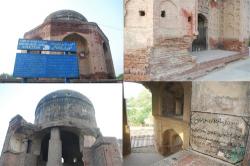 Lahore - About 315-year-old Mughal-era national heritage monument, the tomb of Khan-e-Jahan Bahadur Zafar Jang Kokaltash, is a picture of sheer neglect of the Archaeology Department despite being declared a protected monument and national heritage. Khan-e-Jahan Kokaltash was among the nobles in the regime of Mughal Emperor Aurangzeb Alamgir, and died in 1697. This double-storey mausoleum is octagonal in plan, with high arches on each side, and stands on a big octagonal platform. The entire building is constructed in cut brickwork without any use of red sandstone, which makes it significant among other buildings of that period. The 35-foot wide octagonal platform is about five-foot high from the ground, with four steps of thin bricks, most of which are broken. This dome is 80-foot high from its foundation. According to a 69-year-old local, Javed Ahmad, the right side of the tomb was totally damaged during the 1971 war with India when a bomb hit it.
Lahore - About 315-year-old Mughal-era national heritage monument, the tomb of Khan-e-Jahan Bahadur Zafar Jang Kokaltash, is a picture of sheer neglect of the Archaeology Department despite being declared a protected monument and national heritage. Khan-e-Jahan Kokaltash was among the nobles in the regime of Mughal Emperor Aurangzeb Alamgir, and died in 1697. This double-storey mausoleum is octagonal in plan, with high arches on each side, and stands on a big octagonal platform. The entire building is constructed in cut brickwork without any use of red sandstone, which makes it significant among other buildings of that period. The 35-foot wide octagonal platform is about five-foot high from the ground, with four steps of thin bricks, most of which are broken. This dome is 80-foot high from its foundation. According to a 69-year-old local, Javed Ahmad, the right side of the tomb was totally damaged during the 1971 war with India when a bomb hit it.
http://www.dailytimes.com.pk/default.asp?page=2012%5C07%5C30%5Cstory_30-7-2012_pg13_2
USA – 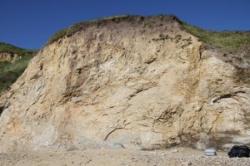 - Point Reyes - Newland, an archaeologist at Sonoma State University and the president of the Society for California Archaeology, was hunting for Native American artifacts, clues about what life was like in coastal California before Europeans arrived. It was easy for him to find them; wind, rain and tides have eroded these cliffs and exposed the ancient trash piles and stone tools. This site and these cultural resources — some of them a thousand years old or more — might not be around for much longer. These pieces of California’s history are in danger of disappearing as the Pacific Ocean claws at the base of this cliff. Sea level rise is accelerating the problem. Newland says there is evidence that people have lived in California for at least 11,000 years, and the soft sandstone cliffs on the coast have always been susceptible to erosion. Traditionally, Tipon said, the tribe would have let the ocean take burial sites, since it was a natural process. But now, with two million or so people visiting the park every year, they can’t leave human remains exposed. Point Reyes contains more than 120 Coast Miwok settlement sites. (The Federated Indians of Graton Rancheria includes both the Coast Miwok and the Southern Pomo people.) The National Park Service works closely with Native Americans to protect graves and other important objects or sites.
- Point Reyes - Newland, an archaeologist at Sonoma State University and the president of the Society for California Archaeology, was hunting for Native American artifacts, clues about what life was like in coastal California before Europeans arrived. It was easy for him to find them; wind, rain and tides have eroded these cliffs and exposed the ancient trash piles and stone tools. This site and these cultural resources — some of them a thousand years old or more — might not be around for much longer. These pieces of California’s history are in danger of disappearing as the Pacific Ocean claws at the base of this cliff. Sea level rise is accelerating the problem. Newland says there is evidence that people have lived in California for at least 11,000 years, and the soft sandstone cliffs on the coast have always been susceptible to erosion. Traditionally, Tipon said, the tribe would have let the ocean take burial sites, since it was a natural process. But now, with two million or so people visiting the park every year, they can’t leave human remains exposed. Point Reyes contains more than 120 Coast Miwok settlement sites. (The Federated Indians of Graton Rancheria includes both the Coast Miwok and the Southern Pomo people.) The National Park Service works closely with Native Americans to protect graves and other important objects or sites.
http://blogs.kqed.org/climatewatch/2012/07/29/rising-seas-threaten-californias-coastal-past/
ROYAUME UNI – Colchester - Archaeologists have unearthed a Roman road beneath a former Colchester pub. A dig at the site of the Stockwell Arms, in West Stockwell Street, has revealed an unexpected glimpse into our history. The discovery could mean historians have to revise their drawings of Colchester circa 40AD, after the road was found three metres away from where they thought it would be. The road would have run from north to south, through the ancient settlement of Camulodunum. The dig has also turned up pottery, plates and a pin believed to be from a piece of Roman jewellery.
http://www.gazette-news.co.uk/news/local/9845037.Roman_road_found_beneath_the_Stockwell_Arms/
ITALIE – 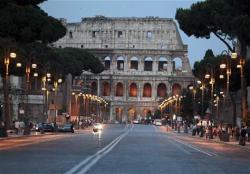 Rome - The ancient Colosseum of Rome, where gladiators fought for their lives, is slanting about 40 cm (16 inches) lower on the south side than on the north, and authorities are investigating whether it needs urgent repairs. Professor Giorgio Monti, from La Sapienza's construction technology department, warned there may be a crack in the base below the amphitheatre. "The slab of concrete on which the Colosseum rests, which is like a 13-metre (yard)-thick oval doughnut, may have a fracture inside it," he told the newspaper. He said intervention could be necessary if the concerns are confirmed, along the lines of stabilization work carried out in Pisa, but he said it was too early to judge what kind of intervention would be most suitable.
Rome - The ancient Colosseum of Rome, where gladiators fought for their lives, is slanting about 40 cm (16 inches) lower on the south side than on the north, and authorities are investigating whether it needs urgent repairs. Professor Giorgio Monti, from La Sapienza's construction technology department, warned there may be a crack in the base below the amphitheatre. "The slab of concrete on which the Colosseum rests, which is like a 13-metre (yard)-thick oval doughnut, may have a fracture inside it," he told the newspaper. He said intervention could be necessary if the concerns are confirmed, along the lines of stabilization work carried out in Pisa, but he said it was too early to judge what kind of intervention would be most suitable.
http://today.msnbc.msn.com/id/48385525/ns/world_news-europe/#.UBbWTLQ5L7F